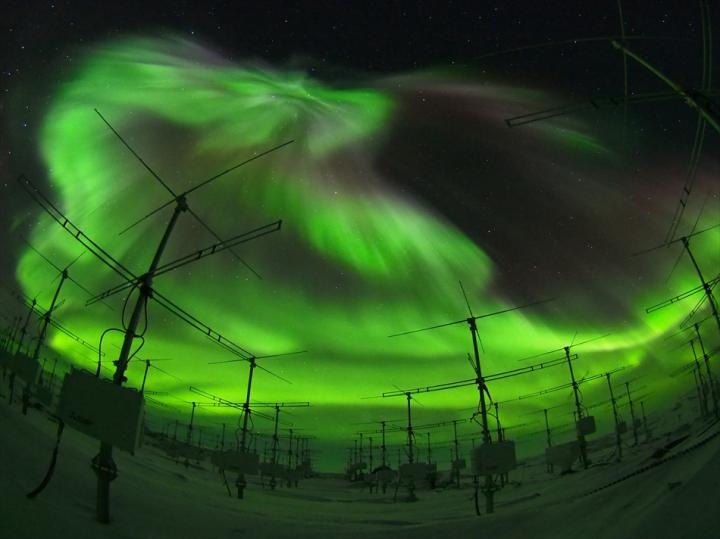Nov 28 2019
About 60 to 600 miles above Earth’s surface, the night sky appears chaotic. This layer of Earth’s atmosphere is known as the ionosphere and gets blasted by solar radiation that splits the bonds of ions. The remnants are heavy ions and free electrons, which continuously collide with one another.
 The Program of the Antarctic Syowa Mesosphere-Stratosphere-Troposphere/Incoherent Scatter radar (PANSY radar) consisting of an active phased array of 1045 Yagi antennas. Image Credit: Taishi Hashimoto (NIPR)
The Program of the Antarctic Syowa Mesosphere-Stratosphere-Troposphere/Incoherent Scatter radar (PANSY radar) consisting of an active phased array of 1045 Yagi antennas. Image Credit: Taishi Hashimoto (NIPR)
In the past, this dance was measured through a technique called incoherent scatter radar in the northern hemisphere, where scientists stream radio waves into the ionosphere. The electrons in the atmosphere distribute the radio wave “incoherently.” The distinct ways in which they scatter inform scientists about the particles inhabiting the layer.
Recently, scientists have used radar in Antarctica to carry out the first measurements from the Antarctic region. They have reported their initial results in the September 17th issue of the Journal of Atmospheric and Oceanic Technology.
Incoherent scatter radar is currently the most powerful tool available to investigate the ionosphere because it covers a wide altitudinal range and it observes essential ionospheric parameters such as electron density, ion velocity, ion, and electron temperatures, as well as ion compositions.
Taishi Hashimoto, Assistant Professor, National Institute of Polar Research
Although these radars are robust, they are also uncommon because of their size and power requirements.
In 2015, scientists used the Program of the Antarctic Syowa Mesosphere-Stratosphere-Troposphere/Incoherent Scatter (PANSY) radar, the biggest fine-resolution atmospheric radar in the Antarctic, to perform the first incoherent scatter radar observations in the southern hemisphere. In 2017, they also recorded the first 24-hour observation.
Hashimoto and colleagues hoped to see major variations between the northern measurements and the southern measurements during the analysis of these observations, as Earth’s lower atmosphere has a large asymmetry between hemispheres.
Clearly, observations in the southern hemisphere are crucial to revealing global features of both the atmosphere and the ionosphere.
Taishi Hashimoto, Assistant Professor, National Institute of Polar Research
However, it is not as easy as taking the measurements. Considering the radar as a pebble bounced across a pond’s surface, the scientists intend to discover how the pebble vertically displaces the water as it bounces and ultimately sinks. They are not keen to know about the concentric ripples formed at each bounce, but they are so similar that it is hard to distinguish which measurements are the ones required.
These ripples are called field-aligned irregularities, and Hashimoto’s team used a computer program that can identify the different signals and curbs the irregularities that could hide the data.
Our next step will be the simultaneous observation of ionosphere incoherent scatter and field-aligned irregularities, since the suppression and extraction are using the same principle from different aspects. We are also planning to apply the same technique to obtain other types of plasma parameters, such as the drive velocity and ion temperature, leading to a better understanding of auroras.
Taishi Hashimoto, Assistant Professor, National Institute of Polar Research
Other authors of the study include Akinori Saito of the Division of Earth and Planetary Sciences at Kyoto University, Koji Nishimura and Masaki Tsutsumi of the National Institute of Polar Research, Kaoru Sato of the Department of Earth and Planetary Science at the University of Tokyo, and Toru Sato of the Department of Communications and Computer Engineering at Kyoto University.